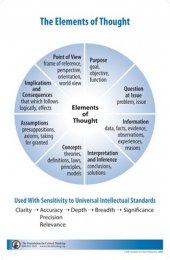
Wheel of Reason
Welcome to the wheel of reason, the section of our critical thinking
academy focused on helping you develop your ability to analyze
articles, essays, books, texts of any kind, professional and academic
subjects, concepts, work products and constructs, as well as
problems and issues you face in your professional or personal life.
In parts of this section, we offer specimen answers developed by our scholars and community. In other parts, we offer templates for you to work out your own analyses.
In parts of this section, we offer specimen answers developed by our scholars and community. In other parts, we offer templates for you to work out your own analyses.
Before attempting to analyze the logic of an article, book, construct, issue, or idea,
see our model of the elements of reasoning. This model is based
fundamentally in
the original work of Dr. Richard Paul, and is an essential component in the Paul–
Elder framework for critical thinking™. Refer back to this model frequently to
refresh your memory as to the eight elements of reasoning that are present in your
thinking whenever you reason through anything. These same elements are present
in everyone else’s reasoning as well, so use them as tools to understand others’
reasoning, as well as your own. For a deeper understanding of the elements of
reasoning, read
The Thinker’s Guide to Analytic Thinking by Linda Elder and Richard Paul.
Video Series
Elements of Reasoning
There are essential dimensions of thinking that humans need to master in order to learn how to deconstruct and upgrade their thinking. People need to be able to identify the "parts" of their thinking and assess their use of these parts of thinking, as follows: • All reasoning has a purpose • All reasoning is an attempt to figure something out, to settle some question, to solve some problem • All reasoning is based on assumptions • All reasoning is done from some point of view • All reasoning is based on data, information, and evidence • All reasoning is expressed through, and shaped by, concepts and ideas • All reasoning contains inferences by which we draw conclusions and give meaning to data • All reasoning leads somewhere, has implications and consequences This video collections unpacks the elements of reasoning and explains how they are essential to reasoning through content, and within all parts of life.
View Videos in the Series
There are essential dimensions of thinking that humans need to master in order to learn how to deconstruct and upgrade their thinking. People need to be able to identify the "parts" of their thinking and assess their use of these parts of thinking, as follows: • All reasoning has a purpose • All reasoning is an attempt to figure something out, to settle some question, to solve some problem • All reasoning is based on assumptions • All reasoning is done from some point of view • All reasoning is based on data, information, and evidence • All reasoning is expressed through, and shaped by, concepts and ideas • All reasoning contains inferences by which we draw conclusions and give meaning to data • All reasoning leads somewhere, has implications and consequences This video collections unpacks the elements of reasoning and explains how they are essential to reasoning through content, and within all parts of life.
View Videos in the Series
Activities for the Wheel of Reason
- Analyze the logic of a problem or issue
- Analyze the logic of an article, essay, or text
- Analyze the logic of any book of nonfiction
- Evaluate an Author’s Reasoning
- Analyze the logic of a character in a novel
- Analyze the logic of a profession, subject, or discipline
- Analyze the logic of a concept or idea
- Distinguishing Inferences and Assumptions
- Thinking Through Conflicting Ideas
